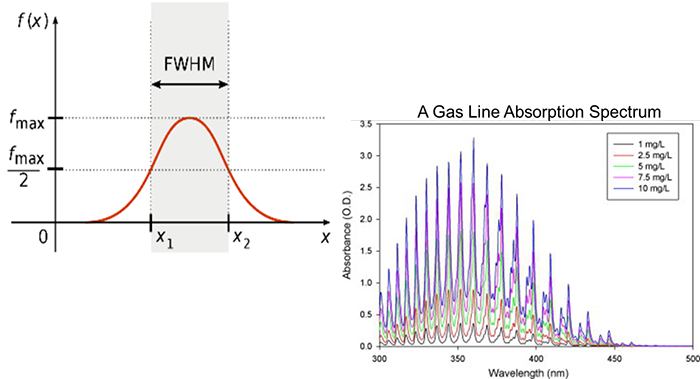What is resolution?

Resolution is the ability to resolve spectral features and bands into their separate components. As such, it is an important experimental parameter. If the resolution is too low, spectral information will be lost, preventing correct identification and characterization of the sample. If the resolution is too high, total measurement time can be longer than necessary. What makes resolution “too low” or “too high” depends upon the particular application, and what information is desired from the experiment. In a UV/Vis spectrum there is spectral resolution that is controlled by the instrument’s slit setting as well as data point resolution defined by the data point collection interval.
First, we need to understand the characteristics of a well resolved absorbance peak generated by a typical spectrophotometer. At left we see a diagram of a single fully resolved absorbance peak. It shows the property of the full peak width at half maximum or FWHM. The FWHM property is an expression of the extent of function given by the difference between the two extreme values of the wavelength (X-axis) at which the absorbance (Y-axis) is equal to half of its maximum value. In other words, it is the width of a spectrum curve measured between those points on the Y-axis which are half the maximum amplitude.
Let’s now consider spectral resolution which is controlled by the slit function (bandwidth) of a spectrophotometer’s monochromator. The slit parameter is usually expressed in terms of wavelength (nanometers). It is important to note that the slit value is not the actual size of the physical slit width in the instrument. The slit width is converted to a wavelength value that allows us to relate the slit width parameter to the FWHM of a spectral peak. The general rule of thumb is that the instrument’s slit width should be at least 5 times less than the FWHM value. The FWHM minimum for most molecules in solution is 60 nm or higher; therefore, a slit width of 6 nm or lower will adequately resolve these peaks. The exceptions to this rule are dissolved organometallic complexes or rare earth compounds, which can have FWHM values of 10 nm or lower. Also, solid samples measured on an integrating sphere could be in this range as well. As seen at bottom right, gases are line absorption materials and have very narrow bands (< 0.01 nm).


